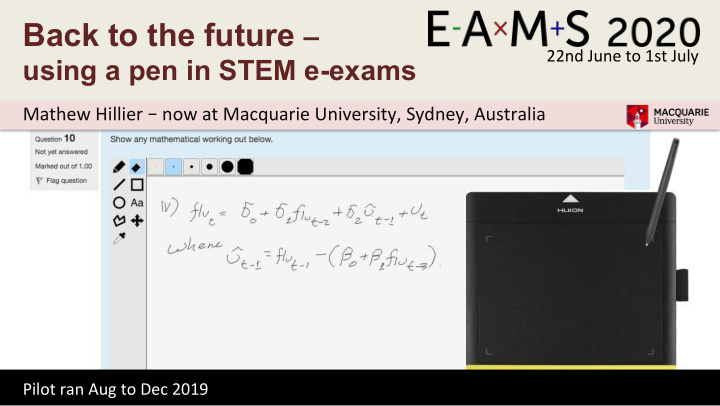



Back to the future – 22nd June to 1st July using a pen in STEM e-exams Mathew Hillier – now at Macquarie University, Sydney, Australia Pilot ran Aug to Dec 2019
Quick context • UNSW – top 100 research intensive, 59,000 students and 7,000 staff. • New online Master of Data Science unit final exams – approx 150 students across two cohorts. • This presentaMon focused on digital inking in remote invigilated exam in STEM.
Digital Inking for e-Exams : Pilot in 2019 Moodle free hand drawing (Poodll) installed 8 Aug – 1 st pilot 15 Oct remote online exam Annotate an image, free hand drawing, wriMng formulae, drawing diagrams – in Moodle. Commodity $60 USB graphics tablet (needs some pracMce) or touch screen device. In future … images could be transferred to arMficial intelligence marking tool? (e.g. work of Dr. D. Kellerman, UNSW)
Procedure used: Off-campus Invigilated Digital Exams Steps : Off-campus invigilated exams architecture 1. Well before the exam: LMS Teacher InvigilaMon • Academic prepares exam: Set up exam in Moodle. Server on AWS Service provider Set up exam rules. Schedule in invigilaMon service. cam • Student pre-registers at the invigilaMon service Home: BYO Laptop with webcam + Tablet (create account, set Mme zone, set up ID). Web browser 2. Before the exam: Student books exam Mme with InvigilaMon monitoring system invigilaMon service and does technology checks. Moodle or assessment tool 3. Exam Nme : Student login to Moodle. Clicks link to Windows or Apple MacOS exam. Lands at invigilaMon provider. Does technology Internet connecMon 3MBS up 3MBS down check, pre-id checks, room scan. Invigilator does system checks. Clicks start exam. Is taken to Moodle Equipment at home: BYO laptop with (or other tool). Does exam while monitored by webcam. Standard web browser with invigilaMon service. Follow exit steps when done connecMons to invigilaMon service provider (submit file, clear cache etc). and exam materials in Moodle. 4. APer Exam : Exam available for marking in Moodle Digital inking add-on: USB graphics tablet and recording reviewed/flagged by invigilator. Video (digital pen) for digital ink input. viewable by teacher.
Remote exam monitoring and recording
Remote exam – student feedback Feedback following two remote online exams (responses = 26 ~ low response): Students did not have a good Mme... Why? a) Drawing tool was clunky. Onsite v remote: I think this exam b) Vendor staff unfamiliar/unhelpful. was pracMcally … c) Problem with internet during exam : 20 15 Yes 10 5 No 0 Easier No different More difficult But - Many didn’t engage with prac%ce opportuniMes as was instructed.
Pilot findings Successful as a ‘minimum viable product’ . It worked largely as expected on a technical level given the known caveats and context. 25% negaNve feedback from the cohort – but low response rate. Issues partly due to: Students not reading the instrucMons that contained the known issues on • usability and min technical requirements (provided well in advance). Not doing the recommended/meaningful pracMce as advised (i.e. pracMce • required to become proficient in use). Clunky drawing tool. • However the remote exam context also added layers of complexity. •
Contextual factors A first run - early days, so feedback reflects this. Difficult and complex confounding factors : i.e, course design did not include scaffold inking pracMce and this was not able to be addressed, minimal/opMonal opportunity for students to pracMce and they didn’t, students didn’t read instrucMons that included usability caveats, remote proctors unfamiliar with system despite the provider being briefed, could not use surface pros due to web cam angle requirement. ProblemaNc data collecNon : Feedback could only be collected late, it was online only and it was opMonal (due to upstream decree) – thus hard to discern true picture of altude/usability.
Future acMons needed a) Refine/fix the drawing tool to address usability caveats – e.g. fix text tool, remove the ‘move’ tool, bener autosave, copy/paste drawing elements. Will require some funding to address (although minor in the scheme of things!). b) Refine user documentaNon , add videos of use etc. c) PracNce and instrucNons to be built-into the course itself – i.e. scaffold use of the graphics tablet for formaMve/lower stakes learning tasks during the term before students get to the exam. d) Run an inking pilot using on-campus lab machines to minimise confounding factors and move forward from that (that includes the other points!). i.e follow procedures used in DET e-exam grant pilots. e) Revisit the remote proctoring use case later!
e-Exams: What works and what doesn’t • Digital inking = must get students to pracMce mulMple Mmes -> ensure course design has scaffolded use in formaMve/low stakes before the exam. It can work! • Remote proctoring vendors ~ don ’ t ask, don ’ t tell. -> Needs simultaneous silng capacity. Careful about logisMcs models used by vendor. Students must pracMce. • Delivery … – PC labs + SEB + Moodle = works! (needs generic login) – BYOD + SEB in windows = security fail! (Try Alt boot methods)
Get in touch! Dr Mathew Hillier Now at Macquarie University, Sydney, Australia Mathew.Hillier@gmail.com hnp://mathewhillier.com Other Info (not inking): DET naMonal e-Exam project hnp://TransformingExams.com Cite this: Hillier, M (2020) “Back to the future - using a pen in STEM e-exams”, e-Assessment in mathemaMcs and science conference (online), Newcastle University, PresentaMon 22 nd June. Conference site: hnps://eams.ncl.ac.uk/
Recommend
More recommend